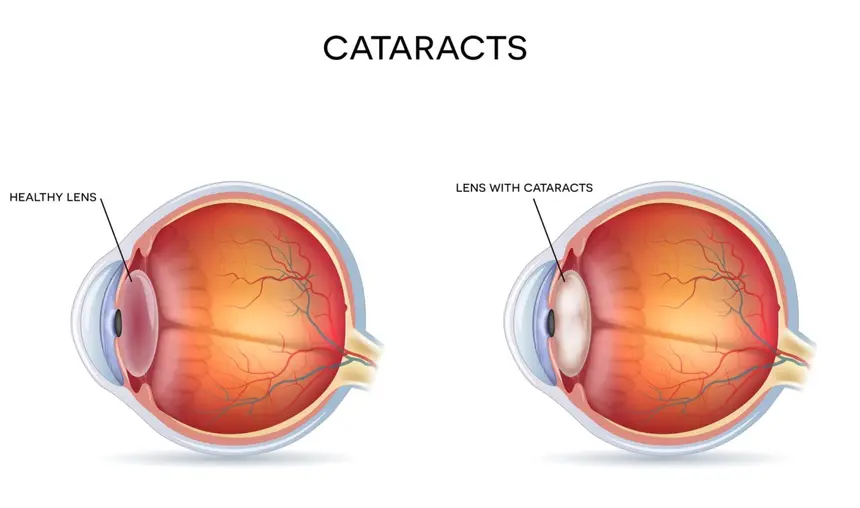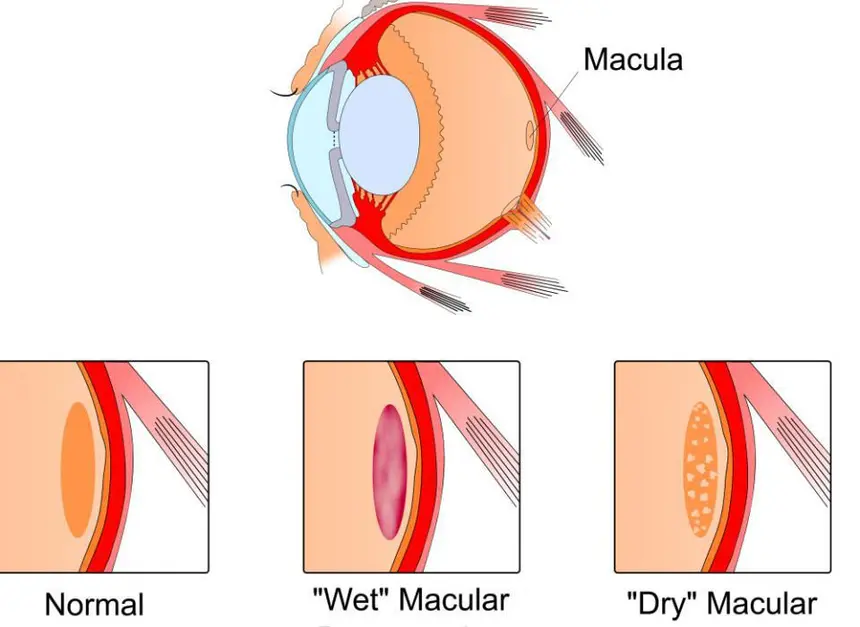The link between age-related macular degeneration (AMD ) and cataracts.
Cataracts and AMD are two health problems that can affect vision, particularly in the elderly. Although cataracts and AMD are different conditions, they have links and similarities. In this article, we'll explore the link between cataracts and AMD, looking at their characteristics, common risk factors and implications for visual health.

Illustration of person with and without cataract
Understanding cataracts and AMD
cataracts
A cataract is an eye condition characterized by the progressive opacification of the crystalline lens, the natural lens of the eye. Normally transparent, the crystalline lens becomes cloudy over time, leading to blurred vision, reduced visual acuity and increased sensitivity to glare. Common risk factors for cataracts include aging, excessive exposure to ultraviolet rays, smoking, certain systemic diseases and the use of certain medications.
Symptoms include :
- Reduced vision
- Poor contrast perception
- Difficulty distinguishing relief
- Impaired color vision
Age-related macular degeneration

Anatomy of the eye with and without cataracts
AMD is a degenerative disease that affects the macula, a small area of the retina responsible for central vision and the perception of fine detail. AMD is the leading cause of vision loss in people over 50. It is divided into two main forms: dry AMD, which progresses slowly, and wet AMD, which is more severe and progresses rapidly. Common risk factors for AMD include age, heredity, smoking, exposure to ultraviolet radiation, a diet low in antioxidants and certain cardiovascular problems.

Illustration of the vision of a person without cataracts

Illustration of the vision of a person with cataracts
We have published another article where you can learn more about AMD and its risk factors.
Symptoms include :
- Blurry or fuzzy vision
- Difficulty recognizing familiar faces
- Straight lines appear wavy
- A dark, empty area or blind spot appears in the center of vision
- Loss of central vision, which is necessary for driving, reading, recognizing faces and performing close-up work

Illustration of the loss of central vision in people with AMD

Anatomy of the eye with and without AMD
Common risk factors
Several risk factors are shared by cataracts and AMD, suggesting a potential link between these two conditions.
Advanced age is the main common risk factor for both conditions,
as they are more common in older people. Epidemiological studies have also identified other common risk factors,
including smoking, excessive exposure to ultraviolet radiation, poor diet,
and a family history of cataracts or AMD.
These risk factors may contribute to the development and progression of both conditions and may help explain why some people develop both cataracts and AMD.

Illustration of the central vision of a person with cataracts and AMD
Cataract surgery
In almost all cases, cataracts can be treated extremely effectively by surgery. Surgical treatment involves removing the crystalline lens from inside the eye, which is then replaced by a tiny, clear, plastic, artificial lens.
Cataract surgery is generally an outpatient procedure, meaning the patient can go home the same day. After the operation, it is important to follow the ophthalmologist's post-operative instructions, particularly regarding medications to be taken, eye care and activities to be avoided during the recovery period.
Cataracts and AMD
In recent years, epidemiological studies have been carried out with contradictory results, sparking debate within the medical community. The central question is whether a patient suffering from both cataract and AMD can undergo cataract surgery without risking the progression of AMD.
Some concerns have been raised about a possible increased risk of developing late AMD following cataract surgery, although it can improve vision. However, recent studies have refuted these potential links. In short, cataract surgery does not appear to contribute to the worsening of AMD.
It should be noted that dense cataracts can sometimes mask the symptoms of AMD. When these dense cataracts are removed and replaced by artificial intraocular lenses, the final clarity of vision will depend on the severity of the underlying AMD. In addition, the characteristic symptoms of AMD, such as distortion or blurring, may become more noticeable once the cataract has been removed. It is therefore important to note that some people may have mistakenly concluded that surgery had worsened their progression of AMD.
Conclusion
In a nutshell, cataract surgery does not worsen AMD. Studies have found no link between cataract surgery and the progression of AMD. While dense cataracts can mask AMD symptoms, removing them can lead to better clarity of vision. Cataract surgery effectively treats cataracts by replacing the cloudy lens with an artificial one. Overall, cataract surgery is safe and can greatly improve vision, but its impact on AMD depends on the severity of the underlying condition. Consulting with an ophthalmologist is essential for personalized treatment decisions.
You can also have access to personalized lifestyle recommendations to prevent AMD by visiting www.macutest.com.
Bibliography
- « What Are Cataracts ? » , American Academy of Ophthalmology, 6 septembre 2022.
- « Cataracts | Macular Disease Foundation Australia » , Macular Disease Foundation Australia, 6 mai 2021.
- « What Is Macular Degeneration ? » , American Academy of Ophthalmology, 6 avril 2023.
- « Age-Related Macular Degeneration (AMD) » , Johns Hopkins Medicine, 8 août 2021.
- H. Osborne, « Macular degeneration vs. Cataracts : Comparisons » , 7 juillet 2022.
- « Cataract Surgery | National Eye Institute ».
- L. Yang, H. Li, X. Zhao, et Y. Pan, « Association between Cataract Surgery and Age-Related Macular Degeneration : A Systematic Review and Meta-Analysis » , Journal of Ophthalmology, vol. 2022.
- « Macular Degeneration and Cataract Surgery : Are They Compatible ? » , American Academy of Ophthalmology, 23 mars 2022.
- S. Bhandari, S. Vitale, E. Agrón, T. E. Clemons, et E. Y. Chew, « Cataract Surgery and the Risk of Developing Late Age-Related Macular Degeneration » , Ophthalmology, vol.
- J. J. Wang et al., « Risk of Age-related Macular Degeneration 3 Years after Cataract Surgery : Paired Eye Comparisons » , Ophthalmology, nov. 2012.
- « Cataracts | Macular Disease Foundation Australia » , Macular Disease Foundation Australia, 6 mai 2021.
The Link Between Diabetes and Age related macular degeneration: How to Protect Your Vision
In this article, we will explore the link between diabetes and Age related macular degeneration (AMD), what macular degeneration is, how it affects the eyes, prevention tips for diabetic macular edema, treatment options, lifestyle changes to protect your vision, and the importance of regular eye check-ups for diabetics.
The link between Age-related Macular Degeneration (AMD) and Alzheimer's Disease
Age-related Macular Degeneration (AMD) and Alzheimer's disease are two significant health concerns among the aging population. While these conditions primarily affect different organs—the eyes and the brain, respectively—emerging research has suggested a potential link between AMD and Alzheimer's.